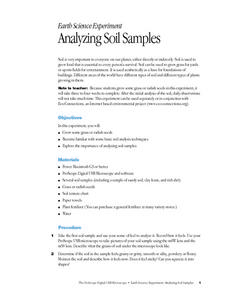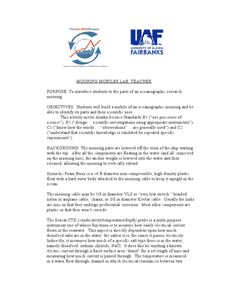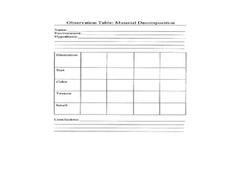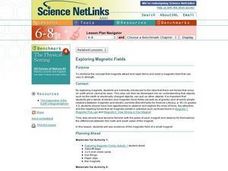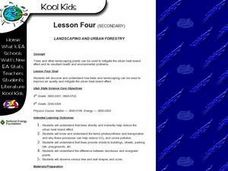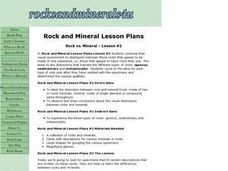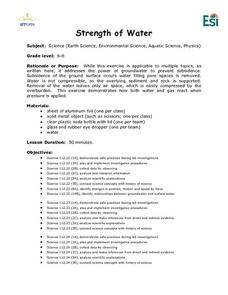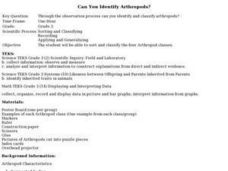Curated OER
Analyzing Soil Samples
Students grow grass or radish seeds in this experiment, which takes three to four weeks to complete. They become familiar with basic soil analysis techniques, as well as, explore the importance of analyzing soil samples.
Curated OER
Mooring Mobiles Lab
Oceanography experts use candy to construct a model of a bio-physical mooring that would test a variety of factors. Each piece of equipment to be included on the mooring is described within the write-up. As pupils gather the candies for...
Curated OER
Light Stick Chemistry
In this descriptive investigation worksheet, 6th graders conduct an investigation to determine if heat energy affects the brightness of a light stick. The students will form a prediction, collect data and answer 3 conclusion questions.
Curated OER
Rock vs. Mineral - Lesson #1
Students describe visual, textural, and other physical qualities of sample rock specimens. Using compare and contrast skills, students sort and classify the specimens according to their assessments of the qualities present in each....
Curated OER
Slow Rot or Not?
Fifth graders examine how environmental factors affect decomposition. In this decomposition lesson, 5th graders experiment with the decomposition of grapes in five different environmental settings. They look at images of items that have...
Curated OER
Time Travel to the Edge of the Universe and Back!
Students analyze the size of the universe and calculate the time to travel to near and distant destinations.
Curated OER
Mathematics Alive: Environment and Design of Human Habitats
Third graders explore the structural composition of buildings and houses. In this math lesson, 3rd graders explain how architecture is related to mathematics. They create a blueprint of a structure with at least three different spaces.
Curated OER
The Great Pollinators
Students discover the reproductive parts of a plant. In this biology lesson, students identify and categorize several different plants they dissect in class. Students record their information using a data chart.
Curated OER
Exploring Magnetic Fields
Students explore the concept that magnets attract and repel items and exert a magnetic field that can vary in strength. They see evidence of the magnetic field of a small magnet. They see that there are forces on earth which cannot be seen.
Curated OER
Integrating Technology: Seeing Atoms: STM
In this atom instructional activity, students learn about the scanning tunneling microscope and answer questions about its use, how it works and its ability to see electrons in atoms.
Curated OER
How Big is a Breath?
Young scholars demonstrate how to use math skills to measure their lung capacity. In this human biology lesson, students use a clear plastic container, measuring cup and rubber balloons to demonstrate how the lungs work. Young scholars...
Curated OER
Landscaping and Urban Forestry - Lesson 4 (Grades 5-6)
Students discuss reasons to plant trees and the best locations for cooling. They analyze two homes identifying types and locations of trees, and location of the central air conditioners. The benefits of shade, the process of...
Curated OER
Landscaping And Urban Forestry - Lesson 4 (Grades 8-9)
Young scholars discuss reasons to plant trees and the best locations for cooling. They study two homes and identify types and locations of trees and determine the placement of the central air conditioners. The class plans a landscape...
Curated OER
Rock vs. Mineral - Lesson #2
Students visually distinguish between those rocks that appear to be made of one substance, vs. those that appear to have more than one. This leads to the distinctions that indicate the different types of rocks: igneous, sedimentary and...
Curated OER
Aquifer Model
Students, after researching and brainstorming about aquifers and locating aquifer maps of Texas, participate in the building of a model of an aquifer complete with a pumping station. They also answer a variety of questions at the...
Curated OER
The Historical and Economic Impact of Military Bases in South Carolina
Eighth graders examine the history of South Carolina's military bases. In this South Carolina history lesson, 8th graders discover details about the history and economic impact of military bases in the state. Students analyze primary...
Curated OER
Solar Cycle
Learners explore the solar cycle through a series of experiments. In this space science activity, students construct and evaluate solar cycle graphs. They explain how this phenomenon affects the Earth.
Curated OER
What Shape Is It?
Students predict the shape of an unknown object by bouncing a ball on it. In this physics lesson, students relate this activity to how dolphins use echo-location to navigate. They analyze their lab result and discuss findings.
Curated OER
Sniff and Guess
Students use the sense of smell to identify the contents of the Mystery Odor Cans. They record what they think is in the Odor Can.
Curated OER
Can You Tell By Touch?
Students feel inside a bag and use only their sense of touch to describe and identify one of the objects that is inside the bag.
Curated OER
Can You Match Them?
Students find pairs of matching sounds by shaking lidded containers and listening to the sounds that are generated.
Curated OER
History of Atomic Theory
Students study the significance of the quantum model and how scientific theories adapt over time. In this investigative lesson students describe the contributions that scientists have helped develop the atomic theory and identify the...
Curated OER
Strength of Water
Students perform experiments using flexible bottles of water and eyedroppers partially filled and placed in the bottle. They record what happens when they tighten the bottle lid and squeeze the bottle.
Curated OER
Can You Identify Arthropods?
Third graders sort and classify the four Arthropod classes. They are given puzzle pieces of one Arthropod example. Each group is to put their puzzle together, glue it on a piece of construction paper and label the ir puzzle.


